The Sony FE 2/28 is a small and affordable fast prime for the Sony Alpha 7 series. Can it convince in the field as well as on paper? I have owned it for more than three years now and share my experience in this long-term review.
Sample Images
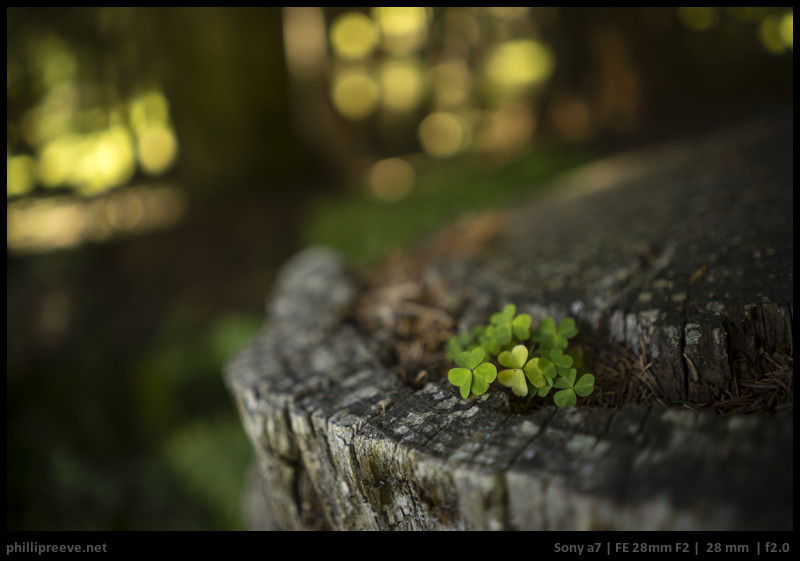
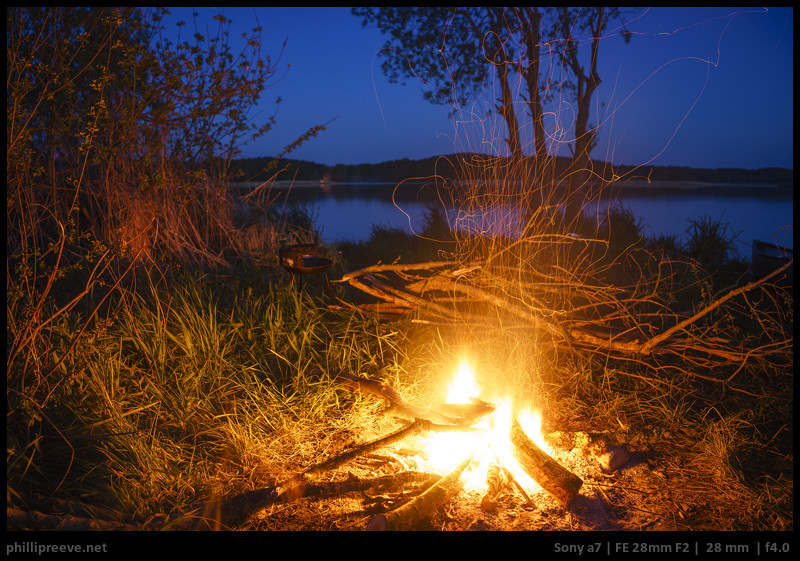
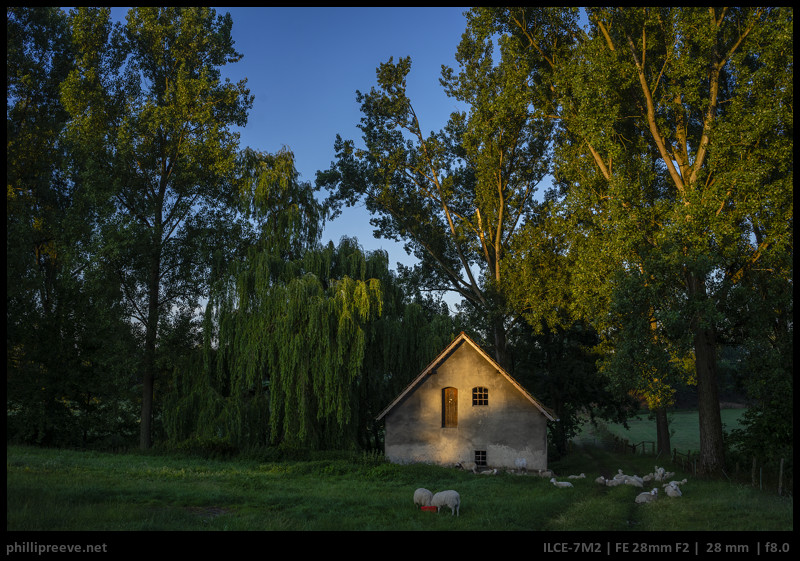
Specifications
| Diameter | 64 mm |
| Length | 60 mm |
| Filter Thread | 49 mm |
| Weight | 200 g |
| Max. Magnification | 1:6.6 |
| Close Focusing Distance from the sensor | 0.29 m |
| Number of aperture blades | 9 (rounded) |
| Elements/ Groups | 9/8 |
The Sony FE 2/28 sells for $448 at amazon.com or B&H photo (affiliate links). If you purchase the lens through one of these affiliate-links I get a small compensation with no additional cost to you.
Contents
 Build Quality
Build Quality
The Fe 2/28 has a metal mount. The focusing ring and the lower part of the lens hull are made from aluminium.The upper part of the lens (a bit more shiny in the picture), the filter thread and the intestines are made from plastics.
This design looks quite nice but the softer aluminium easily attracts scratches of which my copy now has quite a few.
The focusing ring feels very smooth but it offers enough resistance and it has zero play.
The lens hood is a bit flimsy, rather thin and cheap plastic, it is the same as the one for the old E 3.5-5.6/18-55 Kit lens. Sony’s ZA lenses have much nicer hoods.
All in all I think the build quality is okay but nothing to get excited about.
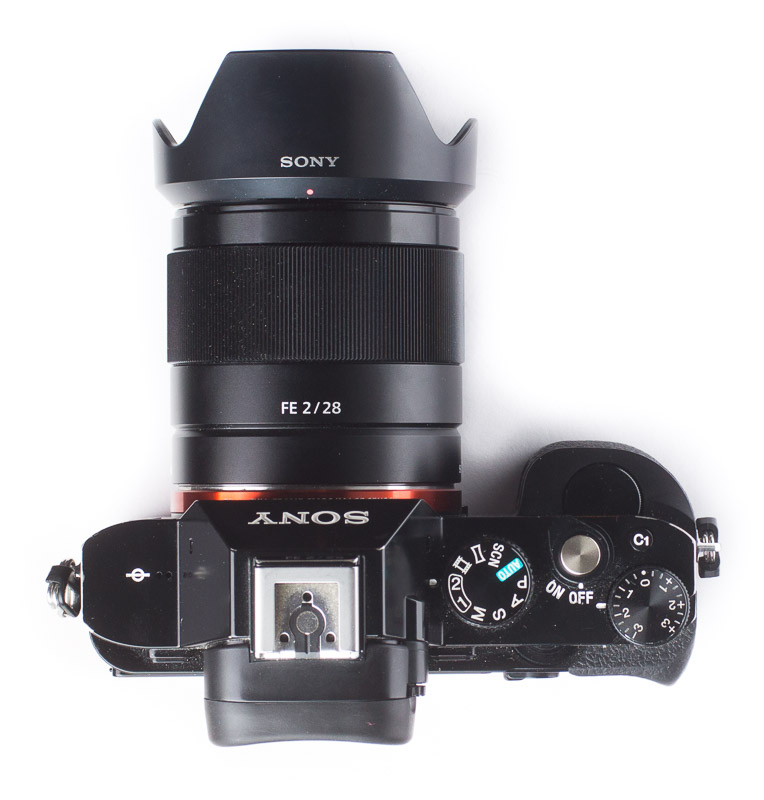
Size,Weight and Handling
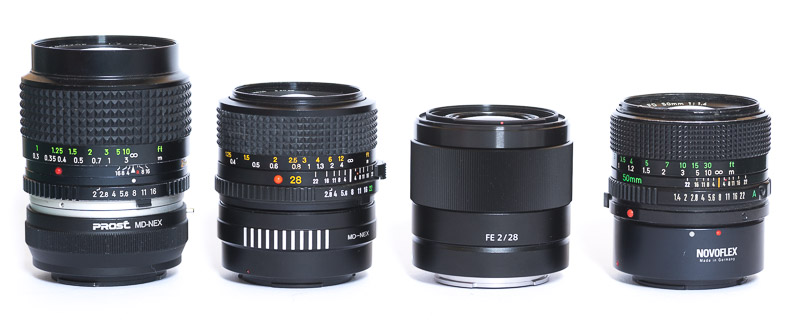
The lens is very small for a fast 28mm lens, above you see it besides a much bigger and heavier Minolta MC 2/28 and a still bigger Minolta 2.8/28. At 200g the lens is also the lightest 2/28mm lens I know of. The FE 2.8/35 is even shorter and lighter but also a stop slower.
Handling is quite good overall, the focusing ring is very wide and feels nice, the lens hood is just the right size: it protects the front lens effectively without adding too much bulk.
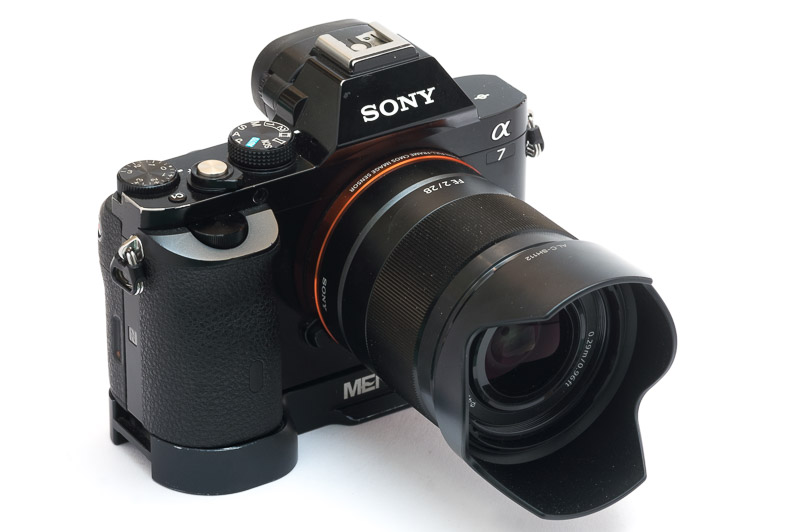
Manual Focus
As mentioned before the focusing ring feels nice, what I don’t like too much is the focus by wire implementation.
The problem here is that it matters how fast you turn the focusing ring, so if I turn it by 20 degrees very fast the focus changes from 29 cm to infinity. If I turn it slowly it takes more than 360 degrees (one full turn) to change focus from the close focusing distance to infinity. It also feels like there is a small lag between the moment when you turn the focusing ring and when the lens reacts.
Manual lenses where the focusing ring is coupled directly to the focusing helicoid are nicer and faster to use but with a little patience you can focus the FE 2/28 very precisely. So manual focus works okay but it isn’t very enjoyable (says a hardcore manual lens user).
Autofocus
AF worked well and precise, it is one of the faster FE lenses. So you will be limited mostly by your camera. On my a7II the small Sony is quite responsive when there is enough light but it slows down noticeably in lower light. On the a7III I would expect excellent performance.
Optical performance
Bokeh
The FE 2/28s bokeh is smooth for a wide-angle lens.
It is very smooth at short distances, still pretty good at portrait distances and more nervous at long distances.
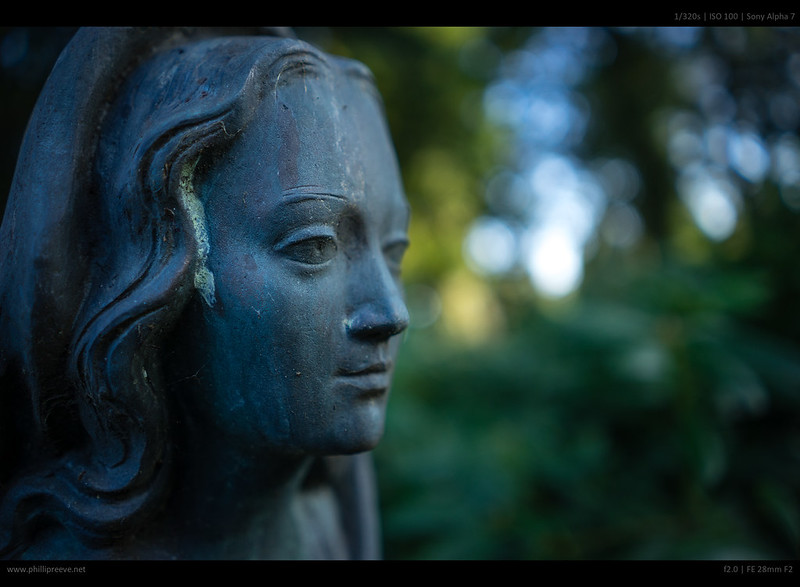


Scenario 1: Close Focus, semi demanding background
Scenario 2: Medium Distance with demanding background
Scenario 3: long Distance with demanding Background
Further Analysis
- Bokeh fringing is very noticeable at f/2 and f/2.8. Not a strength of this lens.
- Under some circumstances one can see some onion ring like structures in highlights.
- Thanks to 9 rounded aperture blades bokeh circles stay pretty round stopped down.
- Cat eyes are pretty obvious at f/2 and at f/2.8 the shape of oof-highlights is still not very even.
Flare resistance
The Sony FE 2/28 shows good flare resistance in most scenarios but under more extreme scenarios some lenses perform better.
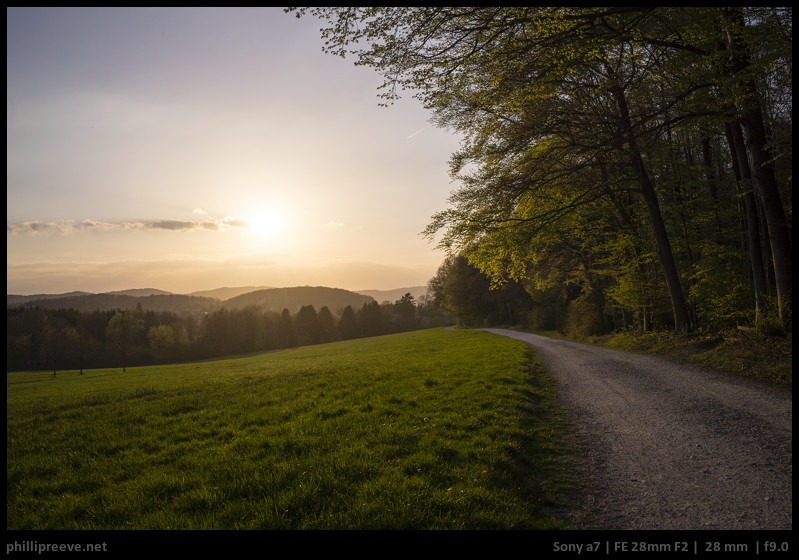
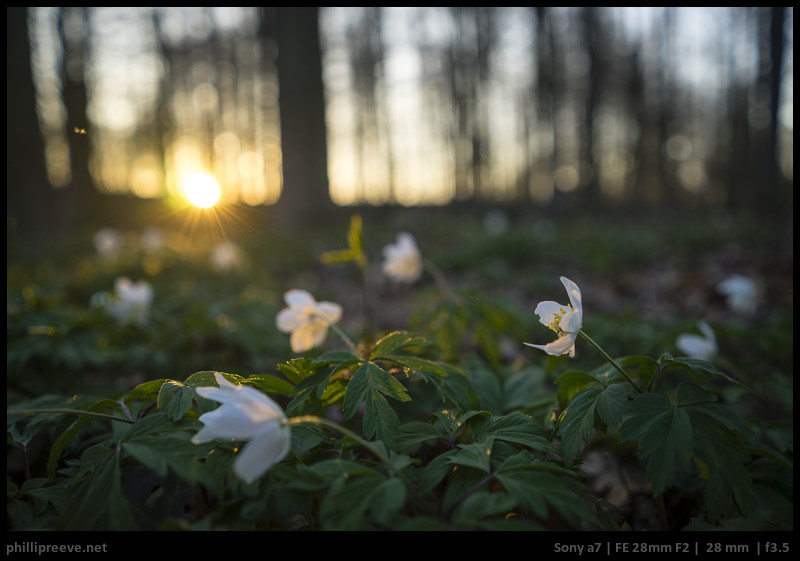
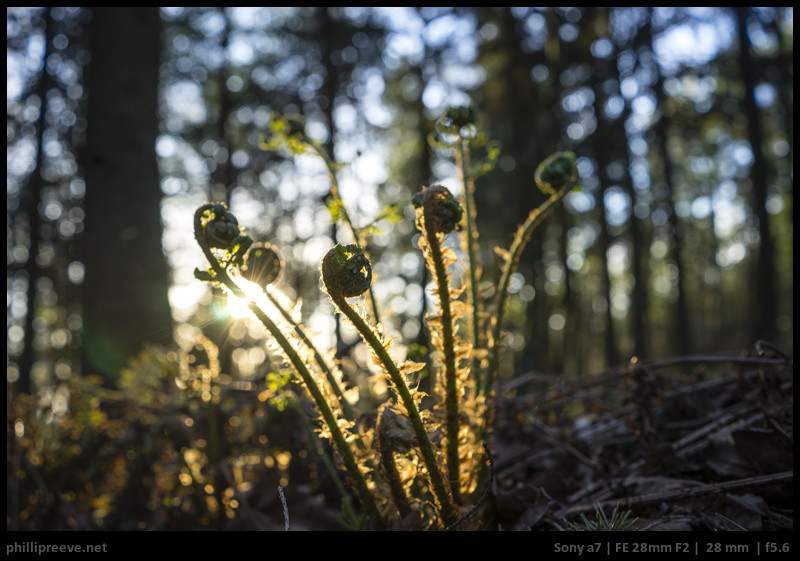
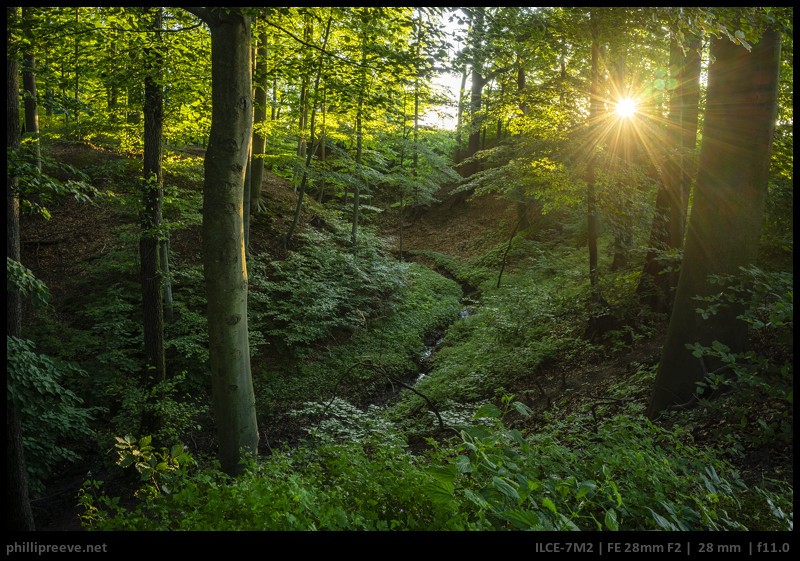

Vignetting
The Sony FE 2/28 shows strong vignetting which is no surprise for such a small lens. My figures are what I measure in LR without any profile applied by me but it includes a forced correction of about 0.5 EV so the true figure is above 3 EV. I also see a little blue-shift towards the corners which has never been an issue in the field.
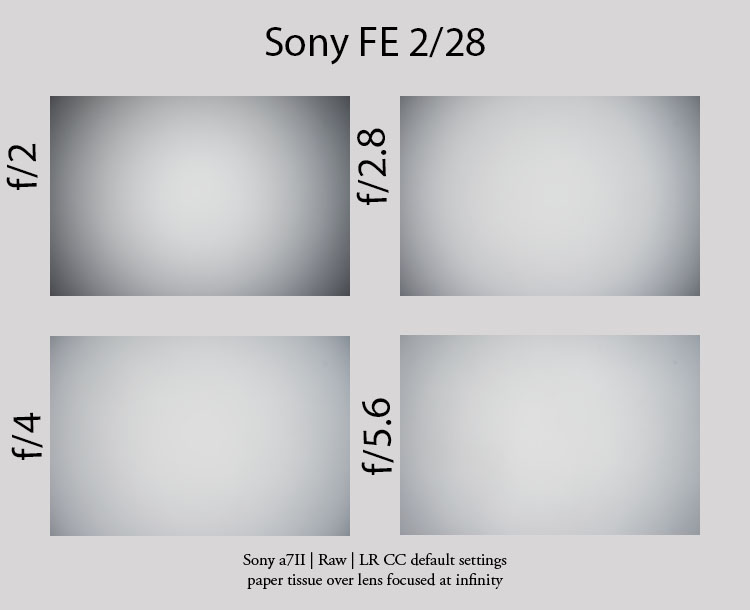
| Aperture | Vignetting |
| f/2 | 2.8 EV |
| f/2.8 | 2.0 EV |
| f/4 | 1.5 EV |
| f/5.6 | 1.3 EV |
| f/8 | 1.2 EV |
If you use the FE 2/28 wide open vignetting is easily noticeable.For most images it will actually have a positive effect on the image since it leads the attention away from the corners but there are applications like astro-photography where this becomes an issue. Vignetting also has a negative effect on bokeh.
Distortion
The Sony shows pretty severe barrel distortion and is clearly meant to be electronically corrected.

It is not so bad that I have noticed it in my landscape images, but if you shoot raw you will have to correct it for any image with a straight line in it and this will cost some resolution.

The lens is not a true 28mm lens, more like a 26mm lens so after distortion correction you have the field of view of a 28mm lens.
Sunstars

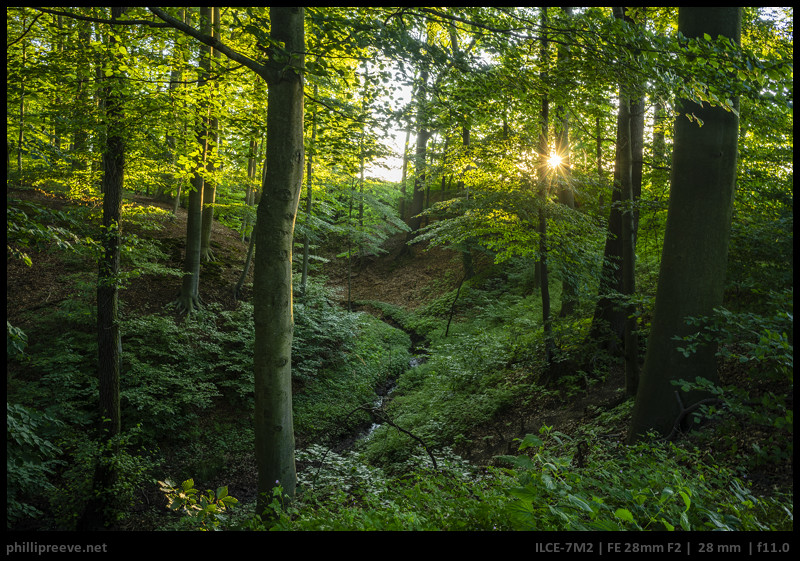
Coma
I was surprised by the pretty decent coma correction of the FE 2/28. It isn’t quite as good as the very best astro-lenses but still good enough to take astro-images you can enlarge quite a bit.
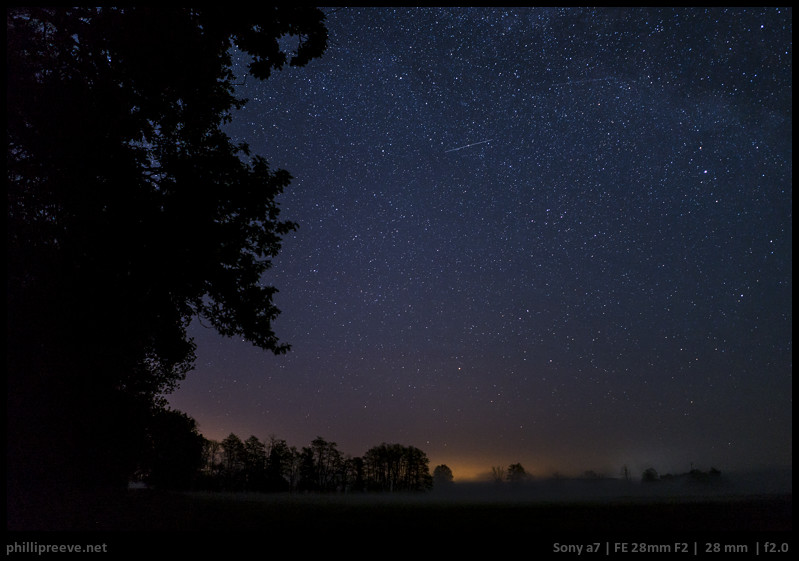
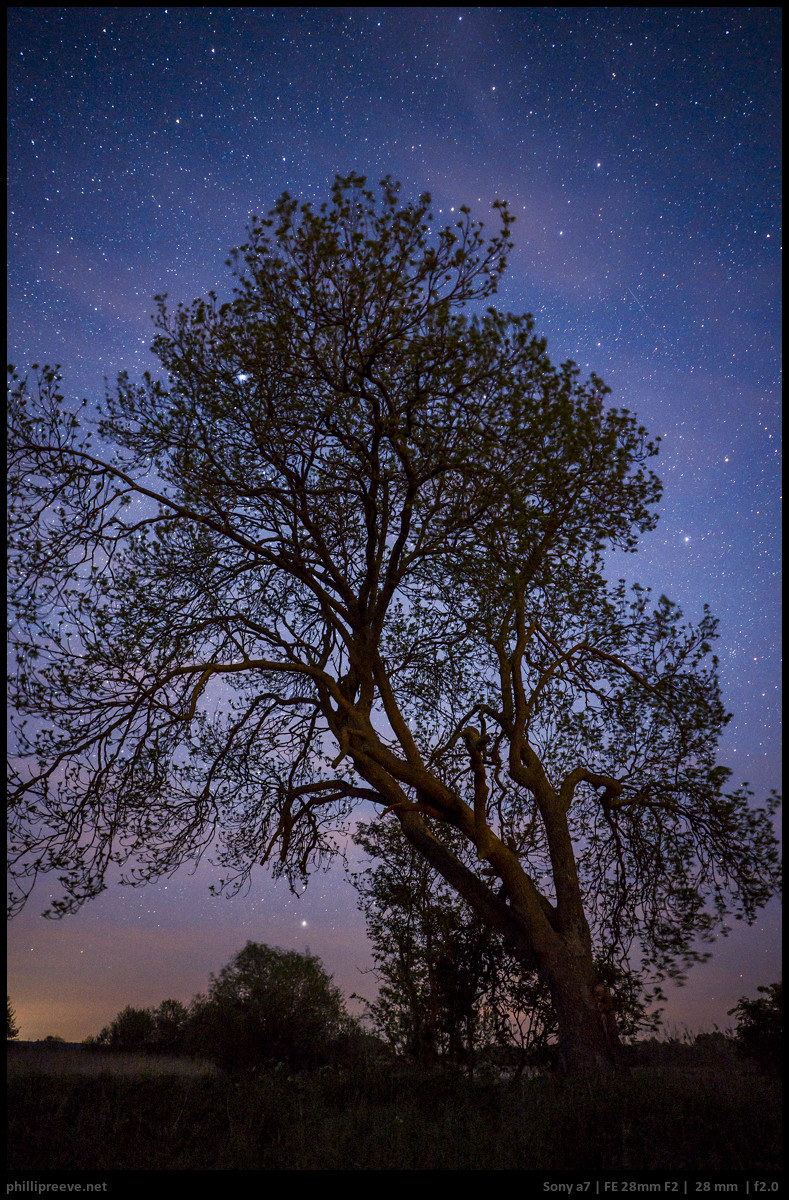
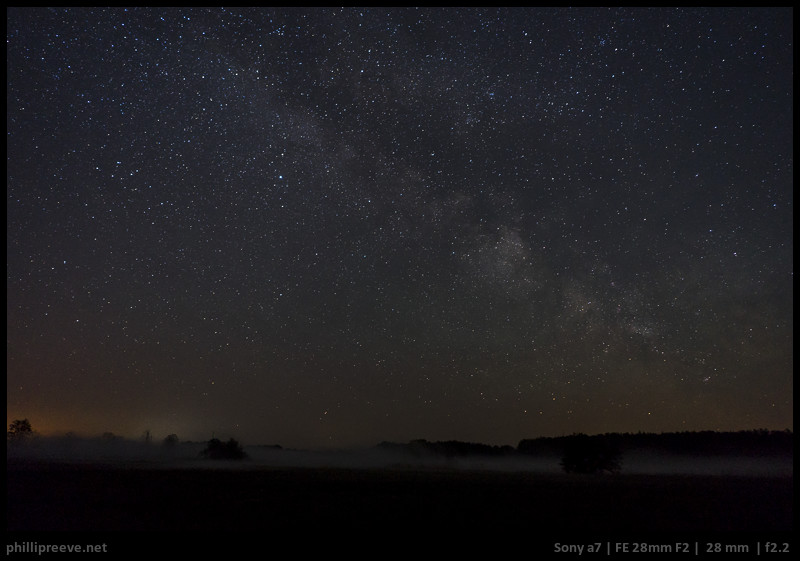
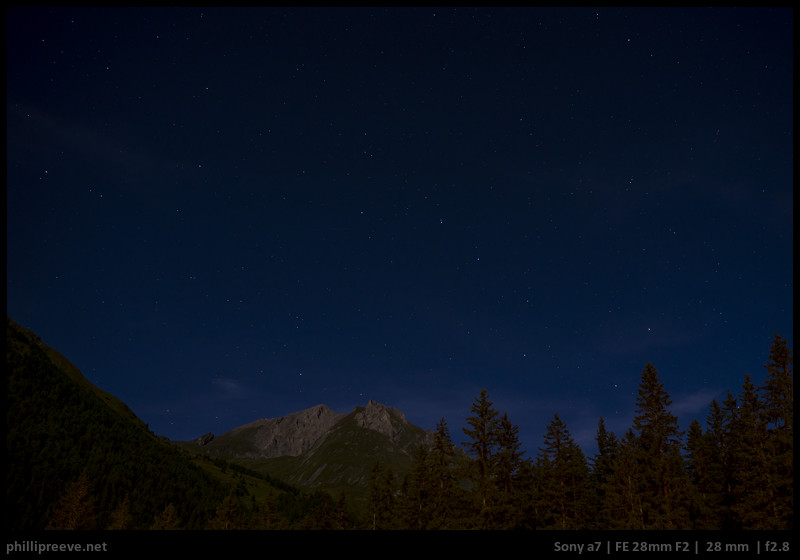
Sharpness
f/2: Contrast is high from f/2. Sharpness high as well if you only look at the center.
The midframe area is less sharp but still acceptable. The corners are softish but you won’t notice this at typical web resolutions.
I think the lens performs a little worse at it’s shortest focusing distance, than at infinity.

the 100% crop shows a very sharp center: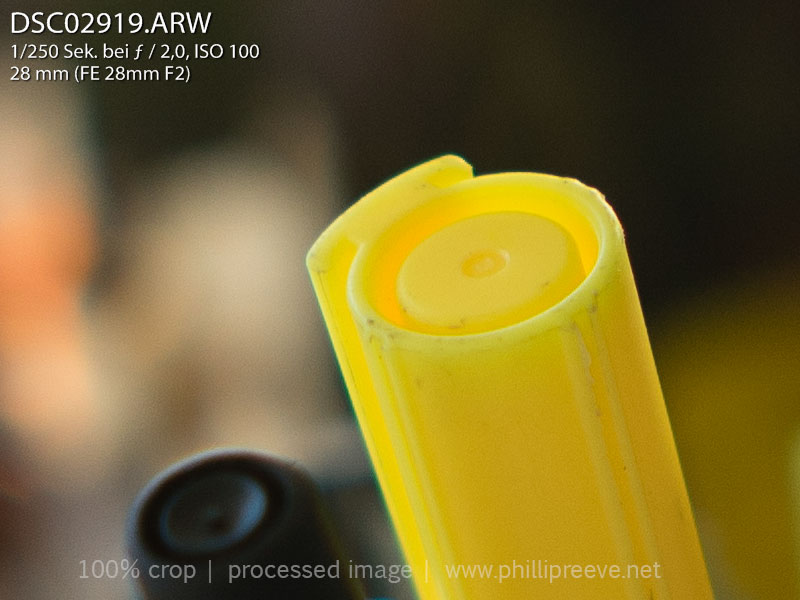
f/2.8: The center improves marginally to excellent levels, the midframe area improves a bit to good levels and the corners improve as well.
f/4: The corners are okay now.
f/5.6: The corners improve quite a bit to good to very good levels.
f/8: The corners improve a little bit and the lens shows excellent to very good across the frame sharpness.

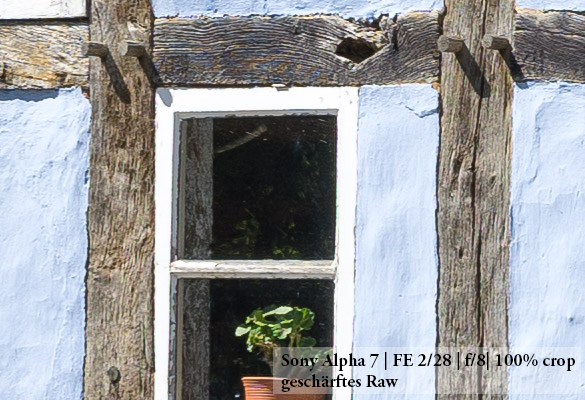
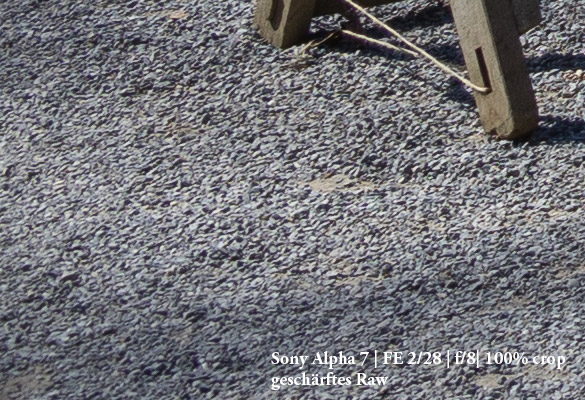
f/11: A little softer because of diffraction.
I think this is a very good overall performance, f/2 is fully usable as long as your subject isn’t too far off-center and stopped down to f/8 it is also a capable landscape lens with very good across the frame sharpness.
Wideangle and Fisheye Conbverter
There are two converters for the SEL28f20, the $248 SEL075UWC (affiliate link) turns it into a 2.8/21 super wide-angle lens and the $299 SEL057FEC (affiliate link) turns it into a 3.5/16 fisheye-lens.
I have not used either converter myself, but because I was asked, here is my take on them:
All the sample images I have seen from the 0.75 converter showed pretty soft corners so I am not really inclined to spend 250€ on it to examine it a bit more carefully.
The fisheye-converter weights more than 400g so together with the 2/28 it would be bigger and heavier than the Sony 4/16-35 ZA OSS and that is already a big lens. If I felt I needed a fisheye lens I would get a manual Minolta 2.8/16, it is a very good and solid lens and it will probably cost less than the converter alone.
Compared to other lenses
The Sony FE 4/16-35 ZA is a very versatile landscape lens. When I go landscaping without serious weight restriction I usually take the zoom because of its versatility. Sharpness is pretty close and which one comes out closer will depend mostly on copy-to-copy variation. One advantage of the FE 2/28 is the slightly better flare resistance.
Pentax K SMC 28mm 1:3.5: The Pentax is cheaper (if you find one), heavier and much slower. It is a tad sharper with similar flare resistance and superior sunstars so I prefer it for landscape photography.
Zeiss Loxia 2.4/25: Because of the distortion correction both lenses are actually pretty close in focal length. The half a stop slower, twice as heavy and three times as expensive Loxia is of course the technically better lens. It is sharper especially off center where it turns in a very good performance from f/2.4 while the FE 2/28 need to be stopped down to f/8 for similar corners. The FE never reaches as excellent off-center sharpness which is especially noticeable on 42MP bodies. In regards to CA, contrast, flare resistance and sunstars the Loxia is also superior. So if you take your landscape photography serious go for the Loxia. As a general purpose lens the Sony is more attractive.
Zeiss Batis 2/25: Again the Sony offers the better value than the bulkier Zeiss which isn’t quite as sharp wide open in the center but significantly sharper off-center with a little higher contrast overall.
The FE 3.5-5.6/28-70 and FE 4/24-70 ZA will perform similar in the center but the FE 2/28 has much better corners, is faster and much smaller. Of course it doesn’t zoom.
The FE 2.8/35 ZA is even smaller an lighter but it is also slower and more expensive. The ZA is very sharp across the frame from f/2.8 and it has less distortion. I think the FE 2/28 makes more sense in addition to the FE 1.8/55 ZA , the FE 2.8/35 is a more universal one lens solution.
Legacy 2/28 lenses like the Olympus OM 2/28 or Minolta MD 2/28 might be a little more affordable and more fun to handle but as far as optical performance is concerned they really struggle with much harsher bokeh and significantly worse sharpness at wider apertures as well as flare issues. The Zeiss 2.8/28 is actually a little sharper across most of the frame but has some corner issues.
For a comparison with some manual lenses like the Zeiss Distagon 2.8/28 and Minolta MC 2/28 check out my comparison. The Sony outperforms the other lenses in most aspects and is smaller than all of them!
Conclusion
pros
|
average
|
cons
|
The Sony FE 2/28 is not a no compromise lens like the Loxia 2.4/25. It comes with some compromises like very strong distortion, softer corners at wide apertures, average build quality and rather strong CA. While sharpness is pretty good it isn’t quite on the same level as that of the three times as expensive Zeiss. If all you care about is printing your 42MP files super large then the FE 2/28 is not for you.
For most photographers though the FE 2/28 should be a very attractive lens since it’s strengths like smooth bokeh, sharpness and speed will weight much more heavily than the cleverly chosen compromises which will rarely have any practical consequences for you apart from the small size and relatively low price.
I found the Sony FE 2/28 to be a versatile lens. At 28mm it is a moderate wideangle lens which does not distort perspective too much and which it works very well in a small 28mm/55mm/85mm kit. Because it is fast at f/2 lens you can still isolate your subject quite well and keep shooting in low light.
The Sony lens offers a very good price to performance ratio. $449 is a fair price in my opinion and Sony only offers few other lenses with a similarly low price like the FE 1.8/85.
All in all the FE 2/28 is a very versatile lens which delivers very good results in most scenarios. It won’t get those excited, who are after the very best, but the compromises it comes with seldom have any real effect on the results and are far outweighted by its many strengths. Highly recommended.
The Sony FE 2/28 sells for $449 at amazon.com or B&H photo, 449€ at Amazon.de (affiliate links).
If this review was helpful to you, please consider using one of my affiliate links. Thanks ?
Other popular articles
- Sony FE 2/28 vs Zeiss 2.8/28 and Minolta MC 2/28
- Manual lenses on the Sony a7 – A beginners guide
- Manual Minolta lenses on the Sony a7
- User-Guide to wide-angle lenses for Sony a7 a7ii a7rii
This site contains affiliate links. If you make a purchase using any of the links marked as affiliate links, I may receive a small commission at no additional cost to you. This helps support the creation of future content.
Latest posts by Phillip Reeve (see all)
- Review: Samyang AF 75/1.8 FE - April 12, 2021
- The FE-List now has 113 lenses on it - March 25, 2021
- 2020 – Year’s end review - December 28, 2020
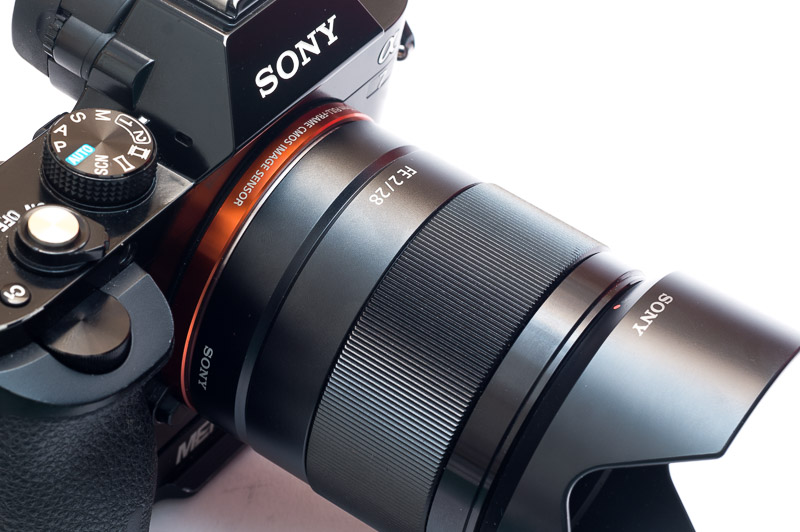



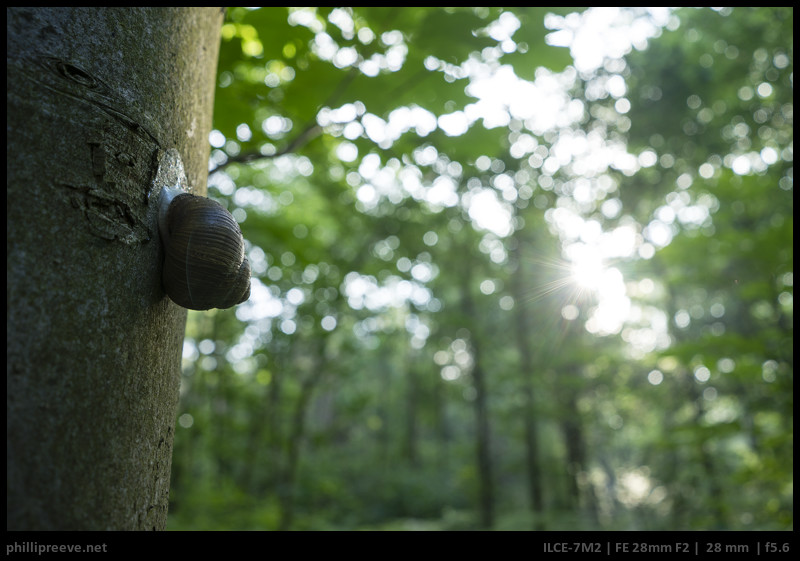








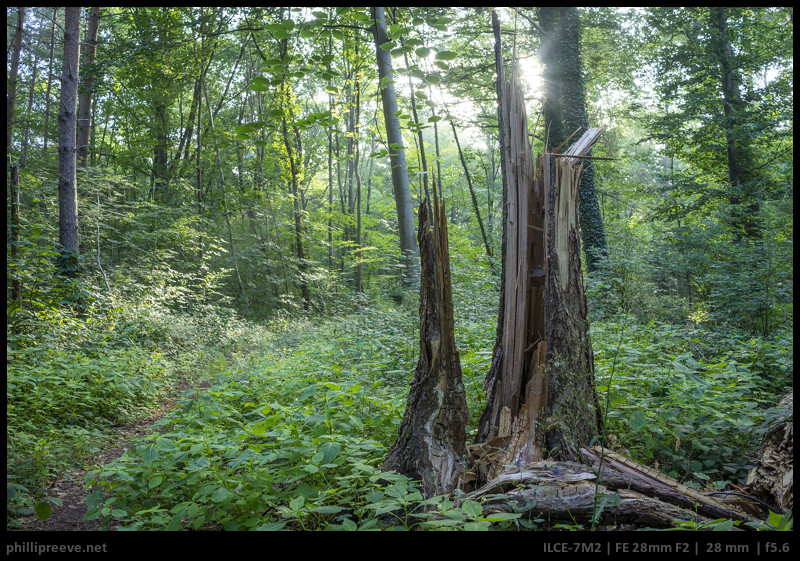
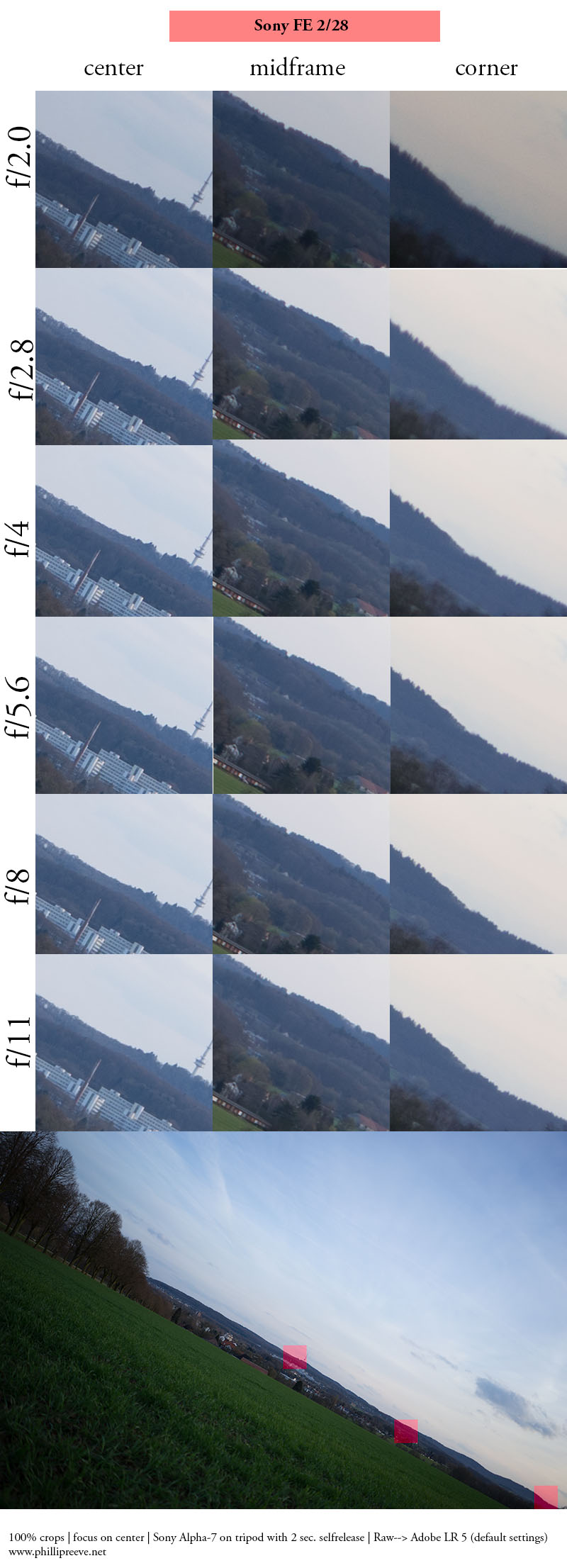
Thank you for a first insight! Seems to be a great lens, though i’m missing optical image stabilization.
with current models with ibis, it’s not a problem.
Looking forward to read the reviews about this lens.
In order to justify the investment, it must be at least as sharp as my Minolta MD 35mm f2.8 and with much better flare control and less vignetting WO.
I do not expect much from the linear UWA adapter in the corners. Those things are a compromise. But even like that, it may be much better than may current UWA (the Minolta MD17mm f4).
You have a valuable source of information here. Nicely done!
hi what do you think abt 16-35 vs 28/21 (with converter) combo. which one would be better at F4
I can only analyze the two test images but boing by them I would think that the 16-35 is much better
Just a small correction, the wide-open sample’s EXIF says it was shot at f/2.8, not at f/2.0.
I am really excited to see your review of the FE 28m f/2. My love is hiking and backpacking, and I want one really solid lens for ~f/8 landscape photography. It is between this and the FE 35mm f/2.8. Your review is the final piece of information I need to decide.
I am looking forward to the lens as well. What I have seen so far confirms the impressions from this analysis, the bokeh might even be betterthan expected.
That’s a really useful information. I’ve been looking for sahrp fast 28mm to replicate Leica Q setup but using my Sony A7III. That seems like a way to go. Thanks
Interesting review, thanks.
However, it’s not possible to compare MTF with Sony-Zeiss 24 because the scale at higher frequency is different (30lp/mm on Sony (and Nikon, by the way) lenses, but 40lp/mm on Sony-Zeiss lenses), so you can only compare the 10lp/mm line.
You are correct to point out the different frequencies plotted but I considered that in my analysis. The 2/24’s 30LP/mm MTF curve will fall between the 20 and 40 LP/mm line plotted in the graph and the Sony’s 40 LP/mm curve will be a bit lower than the 30 LP/mm curve.
At f/2 the tangential 20 LP/mm line from the Zeiss 24 is close to zero, while the FE’s 30 LP/mm lines are both close to 40. And at f/8 the 40LP/mm line falls like a rock as we approach the corners.
I would love for you to compare this lens to the nikon 28mm 2.8 ais lens as it is regarded as one of the best 28mm lenses ever made but it manual focus only.
I would love to do that but I think it won’t happen because I would have to buy one just for that purpose.
Hi Phillip,
Thank you for your review. If you find the time, could you please compare the FE 28-70@28mm with this little gem? I feel that people wonder if is worth the upgrade…
Thank you,
Hendrik
I sold mine a long time ago so I don#t have one available. But I am sure that the FE 2/28 will have much sharper corners
i probably have a bad copy of the sel2870, that said, the 28f2 is alot sharper and offers much more contrast. Also cheap/old FD glass (28/35/50/85) is much better than the 2870.
Thanks for your report so far, looking forward for your compairson with the C/Y 28 2.8 . Especially when it comes to landscapeshooting (sharpness across the frame) and flare resistance.
Thanks for your work and a last question, which version of the CY 28 2.8 do you have?
the f/22 marking is green, I think that means it is the MM version
Just got it today
Yes green should be the MM version, thanks again.
Do you have any idea how this lens performs regarding astrophotography. The big problem is coma for a lot of lenses when used wide open ( here f2.0).
And also with it’s wide angle converter ( to 21mm). Is it so that the luminosity drops to f2.8 with the converter ?
Would be nice to have this one for my a7s
And thanks for this review !!!
We should have a clear sky tonight and I will try to get a shot of the night sky, please check back in 12 hours or so ;-).
Still no starry night or deceiving results ?
And apparently there is a new kid in town, Zeiss, Batis, 25f2.0…
took the image and forgot about posting it, I will post it later in the day 😉
The Batis is very interesting and I am sure that it will have less distortion and a larger sharp area a f/2 but it is also big, hevy and expensive. I would be surprised if it had as nice bokeh.
Thanks for the review!
I wonder how it compares with the Sigma 30/2.8 EX DN on APS-C cameras like the A6000.
Are the mid-frame results here reflects the corner results with the smaller format (but with smaller pixels too )?
I find that very hard to judge, the a6000 has more than twice the pixel density of the a7. And I only used that Sigma for a very short time.
Hi Philipp,
do you have the chance to compare the FE28/2 against the SEL24F18 on an APS-C camera?
Cheers,
Robert
no ;-(
Just got mine in today and did some tests comparing it to the FE 16-35 lens. I compared them both @ f8 on tripod and manual focus. The 16-35 @28mm is clearly sharper and showing better micro contrast across the whole frame. The FE 28 is very close to the 16-35 in the center of frame. Overall contrast is very nice and on par with the 16-35 and other Zeiss optics I own!!! It’s also sharp in the center wide open @f2. I agree with Phillip that this is a wonderful lens for the price and I plan on keeping it.
Hmm, you made me look at my test images again but I stand by my assessment. You can find them here: 4/16-35 , 2/28.
Would you mind sharing your images?
I’d love to share them.
so, just post a link or sent me an E-mail: reeve.phillip at gmail dot com
Just sent you a DropBox link.
thanks for your images. In them the Zeiss shows indeed better microcontrast. But when I look at my own images I see a small advantage for the Sony, not the Zeiss.
Over the years of shooting I have come to expect that every lens has sample variations from one to another. Most of the time it’s small differences from one lens to another, similar to what we are talking about. But sometimes I’ve dealt with bigger variations that have led to ordering as many as 4 of the same lens and cherry picking the best one. In the end I just need to take a deep breath and remember that it’s not the gear that takes good photos!
Thanks for the review.
Im actually new to sony, made the leap from canon 60D. USing the A6000. I am on the fence on Sony ZA 16-35mm ($950) vs Sony 28 f/2 with a fisheye converter (sum=$750). Mainly for landscape and some close up shots at low light situations. Justifying the weight and price difference. I am not a pro but enjoy the experience.
on the a6000 I would go for the 10-18 without hesitation, even if you plan to upgrade to FF in the future
Thank you Philip for a very good completion of the test. I love the new Sony sharpness flare resistance but vignetting is miserable.
Comparing 28mm with 16-35mm and gradually the focus is good in both cases, but vignetting on 28mm 🙁 you show the problem of aperture 7 in a different image. Makes almost hurts to see the picture .-)
I never had any issues with vignetting. Most of my sample images have vignetting added for artistic reasons.
Sure the lens vignettes quite a bit at f/2 but when I use f/2 it’s mostly because I want to focus the viewers attention on the center and vignetting is a means towards that goal.
Excellent review and pictures, as I have come to expect from you Phillip 🙂
Are you going to review the wide angle converter that turns this into a 21mm 2.8?
probably not 😉
Wow, great rolling review of the new 28//2. I keep coming back and finding new additions. When testing sharpness, are you using images with or without lens profile correction? I’m interested to know how the corner and center sharpness of the 28/2 compares to the 35/2.8 AFTER lens profile correction. I am interested because that distortion is really noticeable, and I would probably end up correcting it if I were to use it. Thanks.
I sure hope you can convince Zeiss to let you borrow the Batis 25/2, as I would be very interested to read a review of that lens from you in the future.
thanks ted. The sharpness test is from uncorrected images.
I think after correction the 2.8/35 will be a little better in the center and the corners will prbably be similar.
I will try to get my hands on the Batis lenses
Great review. Could you possibly release a full rez version of the corrected sample of the pic in the “distortion” chapter? it would be great to see the amount of degradation in the corners? Or at least a crop?
done, just click on the image
Thanks a lot, very useful! I think that the right side (with the grass) is the most significant part of the picture for judging the degradation in sharpness (although it may not be exactly in the focus plan). The amount of degradation seems totally acceptable, to my eyes at least.
The lens has major problems and I know because I have it. When I attach my step-up ring and xume adapter on it, the camera fails to allow me to shoot wider open than f/2.8. This makes the lens useless for any video work or for those who want to use it with nd filters attached unless they are okay with shooting at f/2.8 and above. Anyone know a work around to this? I keep step-up rings on all my lenses and find it ridiculous that I can’t shoot at f/2 with them on.
Your stepup ring must interfere with the mechanism which detects the wideangle adapter. Does it report 28 or 21 mm with your step-up ring?
Yes, the camera does report I’m using a 21mm lens with the step-up ring. I’m not sure what to do – perhaps call Sony. It’s a frustrating problem for my work flow.
Here’s in image with my 28mm with step-up ring and xume adapter screwed in.
http://misc.rishio.com/faulty.jpg
Did you manage to solve the problem? I have lots of doubts if I should buy this lens since I would love to shoot some videos with it at some point.
Thanks for the review … I would have liked to see a comparison with/against the obvious vintage contenders, namely the Minolta MD 28mm 1:2.0 and the Canon nFD 28mm 1:2.0.
Especially in the distortion test these should fare far better. For my personal use I don´t care much about AF on a 28mm lens on a 35mm film/sensor; bout your mileage may vary 🙂
Well I already own too many lenses and I can only test what I have.
I would expect that the MD 2/28 (49mm filter thread version) will have less smooth bokeh than the MC 2/28 but it will be sharper and smaller. I don’t know much about the Canon but I think it suffers – as many other FD lenses – with not very durable friction bearings, so I wouldn’t buy one.
I would prefer it as well if the Sony FE 2/28 came without AF and a real focusing ring but there are situations when I am happy to have the AF.
Hey Philip, thanks writing up the review! I’m sure all of us appreciate your time and effort.
I’m debating between the 2/28 and the 2.8/35. How does the image quality compare between the two when they’re both set at f/2.8? Does the Zeiss wide open suffer compared to the Sony stopped down? Any thoughts would be great. Thanks!
goingy by the little data I have I think that the 2.8/35 is a little sharper than the 2/28 which is most notable in the corners. But they are so close that I probably wouldn’t base my decision on that difference
I really don’t like what I’ve experienced from the 28mm F2, sorry 🙁
I’m on my second copy, thinking I’d got a dud, but the second one seems the same.
Specifically: the color, contrast and rendering of this lens compared to any of the Sony/Zeiss lenses is sub-par (and I own all of them and even include the 24-70 as being superior).
I’ve only tested with the A7s so far but both copies have been a big disappointment.
The rendering lacks the 3D pop and creaminess of the 35 F2.8 or 55 F1.8 when used with this camera. It looks more like the Sony 35 F1.8 mounted to my A6000, in other words more flat and 2D.
I’ll try it on the A7 II this weekend, but I am not expecting things to improve.
I’ll stick with the 35 F2.8 which is still my favorite lens, even compared to the 55 F1.8, which can be a little too sterile for my taste.
The Zeiss lenses might be a tiny little bit more contrasty due to different coatings but I think you overexaggerate it by a lot I think the FE 2/28 has very high contrast and nice colors
Hi, Phillip!
What can you say about field curvature of FE 28 f/2?
As far as I can see, field of focus is pretty flat, but want to know your opinion.
I didn’t really look for it but I didn’t see much curvature in any shot. The 4/16-35 has much more
Hi Phillip,
Is the star photo cropped?
no
Hi Phillip. Quick question for you: a lot of people have said that the sigma 30 mm f2.8 dn works well with the a7 as long as you can accept to crop the remaining vignetting end and remove the plastic baffle. It should translate into a 35mm with 92% coverage 18 million pixel. Supposed to be sharp almost to the edge at f2.8! https://luminous-landscape.com/sony-a7r-wishful-thinking/ere is one source:https://luminous-landscape.com/sony-a7r-wishful-thinking/
I mean I can find this lens for €80 euros used. For that price I m ok with playing a bit with LR. Any experience with that?
No personal experience with that lens on the a7 nor have I read anything useful
Thanks for your reply! I will give it a try, I could always resell them for not much cheaper. As you pointed out it’s hard to find a good <25mm in legacy lens that is not to pricey and good quality so the 19mm could do the trick
I would guess that a Canon nFD 2.8/24 will give significantly better results than the Sigma 2.8/19
Thanks for another great review (and comparisons) Phillip. I’m tempted to get one too, despite having many other 28mms! Though a similar style 24mm,(that isn’t F/1.4, huge and very expensive), would be more useful, and a 20mm, even more so.
I ahd the chance to buy a FE 4/16-35 for a very decent price and now I am torn between the FE 2/28’s size and speed and the 16-35’s flexibility. I think there are worse problems to have 😉
Hi Phillip,
Great review. Thank you for confirming what I expected. I just purchased the FE 2/28mm and am very pleased. I love the 28mm point of view. I also have the Ricoh GR for when portability is a priority and it is also wonderful option as well. Speaking of wide angles, now have the 15mm Heliar III (after having the original Heliar) and I must say what a dramatic improvement. It is a really great lens for the A7. Have you tried it?
I habe owned the first version of the Heliar and i used it a lot on the Nex-5n. Now on the a7 15mm are very wide but I would of course like to test it since other photographers liked it a lot. But first I have a rather largd backlog of other lenses 😉
Hi again Phillip,
You inspired me to do a very informal (and I’m sure unscientific) comparison of the FE 28 mm F2 lens against the Ricoh GR fixed 28 (equivalent) lens. I love the little Ricoh, and I must say, it really holds its own. See this link: http://lightgrab.com/ricoh-gr-vs-sony-a7r-with-fe-28-f2-lens/
Phillip: Thanks for the review!
I just received a Sony A7Sii (first Sony I’ve owned, previous Canon 5D owner). I have the 55 1.8 lens. I want one lens for wider-angle street shooting. Something light weight but very effective. (I got the “S” because I shoot in low light a lot: both indoors and outdoors.)
I’m currently trying to decide between the Sony 28 2 versus the Sony 35 2.8 lens. I want a prime, and light weight, but both of these seem very similar. Focal length aside (I think both focal lengths would be okay for me) which do you think is the superior lens? Since I have an A7Sii low light (and thus 2.8 wide open) won’t really be an issue. I’m just trying to see which one offers the best quality shots. Any advice or insights great welcomed.
I think the 2.8/35 might be a bit better in the corners at f/2.8 but on the low resolution a7s you will be hard pressed to see that difference. Personally I would choose the Voigtländer 1.7/35 but thats a manual lens: http://phillipreeve.net/blog/voigtlander-ultron-11-7-35-mm-review/
Phillip: Thanks for the quick response! I definitely need auto-focus the way I shoot and the conditions under which I sometimes shoot. Based on your response there’s not a whole lot to distinguish the two lenses (except for focal length).
Are there any noticeable advantages to the 2.8/35 because of lighter weight (120g vs. 200g) and form factor (I think the 35 is shorter/smaller)? My guess is it’s not that big a difference, but I also have never help/seen both in my hands. 🙂
the 35 is smaller and built quality is a bit better. I think I would choose the 2/28 because of the faster aperture
Phillip: Many thanks, that helps!
Thanks Phillip for the great reviews and posts you generously share on your blog. I find them very useful!
Marc
thanks 🙂
Hallo Phillip,
Was hälst du davon, das 28er an der a6000 zu betreiben?
Vg
Andreas
Ich denke es wird da eine recht gute Figur machen. Wobei das 1.8/35 nochmals etwas attraktiver erscheint
Thanks phillip for your review.. very useful
May i know what kind of profile picture / white balance / to produce 2nd pics above?
Raw / jpeg ?
Tq
Those images are devolped from raw, see this article for more information on my postprocessing: http://phillipreeve.net/blog/how-i-create-images-part-3-postprocessing/
I’m debating getting a Contax Zeiss 28mm 2.8*T Distagon lens – I’m not sure if you can answer this but I’m wondering how this little sony would compare. The Contax will I think be fun to use if thats anything. Contax will be only slightly cheaper.
Actually now that I poke around I see you do compare them!
Great review, I bought this and enjoyed it but now looking to upgrade to a Batis 18mm.
Hi Phillip, I have the FE standard zoom 28-70 and think i want to buy the FE 28mm f2.
Do you think the 28mm will outperform the standard lens at F3,5 to f5.6 apertures? So would I get extra speed and better images in the standard zoom lens spectrum?
yes
Nice review but I’m still trying to get my head around what a “conbvertor” is 🙂
Hi Philip,
I bought a copy of FE 28/2 it seems to suffer from flare. Have you experienced any such issues in case of back lit objects.
Thanks
Rishi
Personally I had zero issues with flare but I have read from others that they had some problems. Could you show some samples?
Bonjour Philip,
Je pars en voyage en Inde avec un A 7II (photos de paysage, rue, architectures, ambiances). Comme la qualité semble similaire entre le 35 et 28 mm, j’hésite vraiment entre les 2 focales (ou un zoom ?) Y a t-il certaines photos que je ne pourrais pas faire avec le 28 ou 35 ?
Du coup quelle focale me conseillez-vous d’acheter sans tenir compte du poids, ni du prix.
Merci
Pascal
Hi Pascal,
if size isn’t a major concern for you I would go for the FE 2/28 because it is a little more versatile because it is faster and wider.
Phillip
Salut Phillip,
Merci pour vos renseignements. Du coup, je lorgne également sur le Zeiss Batis 25mm, sur lequel on dit beaucoup de bien. Sera t-il aussi polyvalent que le Sony 28mm, la qualité est-elle supérieure ? Je recherche surtout un beau piqué et de belles couleurs et une image bien contrastée.
At f/2 the Batis and the Sony are pretty close as long as you subject is in the center of the image. As you move away from the center the Batis maintains sharpness and contrast better. Stopped down to f/8 the difference will be minor.
You need to decide for yourself if the small size and price of the Sony or the better performance of the Batis in some scenarios is more important to you.
Between this and Voigtlander 28mm F2 Ultron, which one would you pick for landscape?
Hmm, that’s a bit tricky. Probably the Voigtlander because of nice sunstars and manual focus though the Sony doesn’t have any field curvature issues.
That’s my problem. I have both lenses because I also have a film M mount camera, but can’t decide between the two.
The Sony doesn’t have field curvature, but it has that awful distortion. Probably both are winners, and you give and take with each of them.
For my next trip I’ll probably go for the Sony because I already have a screw in ND filter for 49mm filter thread.
Hi PhillipReeve,
I read at SAR that Sony has changed internal design of this lens. They have made aperture blades straight in line of their latest lenses, so now 28 gives nice sunstars too.
A comparison with aperture blade pictures was published on SAR couple months back.
Saw it but wasn’t sure if it was just that one sample with a miscalibrated aperture or a real update.
You compare the size of this Sony lens with other lenses, and in the photo all other lenses have the adaptors on. Please mention it because many people may not see it.
since you have to use adapters to use it one the a7 it makes sense this way
I second that. Its really nice of you guys to think this way. For example, my 135/2 a somewhat ok size, became an unweildy lens with MC-11 and I appreciate that you give the real picture.
What about astrophography performance? Is it recommended? Which one would you pick beetwen this lens and Nikon AFS 20mm F/1.8?
I do not have the highest standards but I am pretty happy with it for that purpose.
I just received my third, and best copy to date of the Sony 28/2. I tested it against my Nikon 28/1.8G and its no contest. The Nikon easily beats it. At open, and stopped down apertures, across the frame. The centers are similar, but the edges (and midzones) of the Nikon at f/2, are better than the Sony at f/4! The Sony has severe light fall-off that results in mushy corners, as the correction destroys contrast. The Nikon has much less light fall-off at open apertures. The Nikon wide open (f/1.8) is also at least a half of stop faster than the Sony (f/2) in use. You should give the Nikon a try (with a proper adapter) to see what a high quality 28mm optic can deliver on the A7RII. Testing on the A7 24MP series cameras would not be very demanding or telling. The biggest issue I have seen with the Nikon is poor coma performance, but the Sony isn’t any better.
The Sony is a very good compromise, not the world’s best 28mm. With adapter it is half the weight of the Nikon and half the price.
So if you want to get every pixel out of your a7rii the Nikon is the better lens, that is if you are willing to live with the compromises in usability it comes with. I wonder though: How much of a difference is there at f/8 where I would use it for demanding landscapes?
I have actually been quite happy with the coma performance of the Sony when I had the opportunity to shoot some astro by chance.
Hi Phillip,
I love your site, I’m currently considering switching over to sony from Nikon, and this lens seems like an ideal choice for a part of my kit, focal length, fastness, size, etc.
However, I’ve heard a number of highly conflicting opinions on it, with about half the people saying it’s amazing, and half people saying it’s awful. Do you know if there’s any severe issues with copy variation on this lens?
Thank you for any feedback!
I have heard of a fair number of decentered lenses but until Roger Cicala posts some numbers I can’t give a reliable answer to your question.
Thinking about buying one for a few days… So this long-term review comes at the right time ! Thanks again for your great reviews !
I had this lens and sold it because i found it mediocre for lanscape. The edges of the frame really were not worth a €350 lens.The image stretching needed to correct the strong distortion gives bad edges of the image if used for landscape. For Other uses you might not notice this so much. Center of the frame is ok though. Hope this helps.
I wouldn’t call them bad but ok. Sure others are better but not by that much.
Maybe my copy was not a very good one but at infinity the borders even at f8 were of the quality you would expect from a not excellent zoom lens. I must add that i print quite big so these defects are more visible.
Samyang 24mm f2.8 came out and it would be interesting alternative. Of course it’s slightly wider and a stop slower but they share purpose of compact and light carry around lens.
A great lens for people/street.
I really enjoyed mine, I can’t believe I sold it. I used it primarily for Milky Way shots, with some landscape thrown in.
Using it for Milky Way panoramas was amazing, you can avoid the vignetting wide open by overlapping at least 40%. If you can find one for $350 USD or less, just do it.
Phillip is right; this is a lovely all-rounder. Definitely worth the (very reasonable) tariff charged by Sony.
Thank you for offering this perspective–it is all the more credible for being based on long-term use.
Hi great review, i have the 35mm F1.4 sigma art e-mount, i love the image’s this lens gives me but i really dont like how big and heavy this lens is, i didnt think it would bother me but its got old fast, do you think swapping the sigma 35mm for the 28mm f2 is a good decision? I love idea of the 28mm being so small and light weight but I’m just not sure about the image quality it give on my A7rii
Well I don‘t think it is a real substitute. I would view the 28 as a good addition for when size matters but it isn‘t able to replace it in many roles.
Bonjour – J’adore les contenus de votre site. Vous faites l’impasse sur les vieux Nikkor AI AIS, il y a t il une raison à cela ? Merci encore pour tout ce travail contributif.
In English please 🙂
Hey Phillip,
hast du mal die auf das Objektiv zugeschnittenen Sony-Weitwinkelkonverter ausprobiert? Wäre mal interessant zu wissen wie die sich machen. Das würde das Objektiv noch ein ganzes Stück flexibler und vor allem attraktiver für Reisen machen. Sorry falls das schon mal behandelt wurde und ich es überlesen haben sollte.
LG
Hab ihn noch nicht ausprobiert und was ich an Beispielen gesehen habe fand ich nicht gut genug, um ihn selber einmal auszuprobieren.
Heute gibts das SEL 28mmF2 für 340EUR, abzüglich 40EUR Cashback von Sony sehr attraktiv.
What do you guys think,
when planning to buy a tamron 28-75/f2.8, is there a reason to keep the FE28mmf2?
Na, sold my 28 and 55 after got the 28-75
Hello there
i am a7ii user
sony fe 50mm and sony i have 90mm macro lens
looking at a quick lens in the street and indoor spaces
I don’t take too many landscape pictures
28mm you think a suitable lens
Do you have any other suggestions?
I think the FE 2/28 could work well for you.
Thank you so much for the great reviews you offer! Is there any similar lense that doesn’t do focus-by-wire? Being used to shooting DSLR, I can’t imagining being happy with focus-by-wire. I’m planning to shoot on a sony a6000, however probably going to buy a full frame lense in case i’ll upgrade to the a7 some time soon. I’d love a lense with 24 to 30mm, so something like 35 to 45 on an aps-c sensor. And sure, f2 or better would be great. I know I’m asking for a lot. Do you have any recommendation for me or do you suggest getting used to the focus-by-wire of the FE 2/28? Thanks a lot in advance!
I wouldn’t know any alternative lenses to fit your needs. There are few modern 28mm lenses. There is a solid Canon EF 2.8/28 and a huge Sigma 1.4/28 and there is the hassle of adapting. In conclusion: I think I would go for the FE 2/28.
It looks like my copy of 28/2 produces more pronounced sunstars, doesn’t it?
https://photos.app.goo.gl/CfD1yiecJTZYcXTBA (shot with protective filter, so there’s some additional flare)
The aperture diaphragms of the earlier Sony lenses are all over the place.
You got lucky, Phillip didn’t.
May be the design of aperture blades got tweaked since then? My lens is from recent batches.
While possible I read reports of people buying from new batches and still got very bad sunstars.
So I would not count on it.
The distortion looks epic, worse than the kit zoom. I’ll stick to using my old Nikon 24mm. God, I wish my Fuji lenses would fit my Sony 🙁
Note the typo in “Wideangle and Fisheye Conbverter”
Hey,
I purchased this lens after reading your review (and some others) a couple of months ago. It’s been my first AF lens on Sony (a6500).
To be honest, in the first weeks of testing it drove me from total excitement to almost absolute disappointment and back. 😉
In general, I agree with your review. What I really like about the lens are contrast & colors, flare resistance, sunstars (in most situations) and Bokeh. And of course that it’s very light and small and quite well built.
When it comes to sharpness, especially towards the edges of the image, you need to be careful. The kind of blur in the corners when shot wider open looks quite nasty (some kind of “directional/radial” blur) and “cheap” to my eyes and is going to be visible without pixel peeping.
I found f/6.3 to be some kind of general sweet spot, and f/8 if the corners really matter. But if you want a lens that is usable all over the frame at wider apertures, don’t buy this one.
I also noticed that focusing on the right midframe will lead to an unsharp left midframe, while focusing on the left midframe will lead to an overall very sharp image (might be even a little sharper than when focused on the center) – except for the corners, of course. My Sigma 56mm/1.4 behaves the same by the way… So are both lenses decentered or could there be something wrong with my camera?
But all that criticism above won’t lead me to say it’s a bad lens. If you know its weaknesses and are able to deal with them, you are going to get great images with nice rendering in many situations.
Best regards,
Sebastian
https://www.sonyalpharumors.com/thats-weird-new-versions-of-the-fe-28mm-f-2-have-been-secretly-improved/
Updates on this one 🙂
But beaware of teh decentering issues. I had 4 copies till now and none of them was centered. The latest one is the worst.
Thank you so much for such these good reviews! I learn so much from your website.
I’m now choosing a 28mm lens for my A7CII, between 7Artisans 28mm f1.4+Techart adapters (around $440 in China, used) and FE 28 f2.0 (just for $140, used).
But I always find the auto lenses were a little bit off, kind of boring, not saying they’re bad. I see you guys have a much more detailed review of the manual lens than the auto lens – means you take with them more usually.
I think the look of the lens is also a point that makes me happy. A beautiful lens does make me want to take pictures even more. Could you give me some advice?
If you rely on the AF better get the Sony lens. I wouldn’t recommend to get the 7a 28mm 1.4 to only use on the Techart adapter.